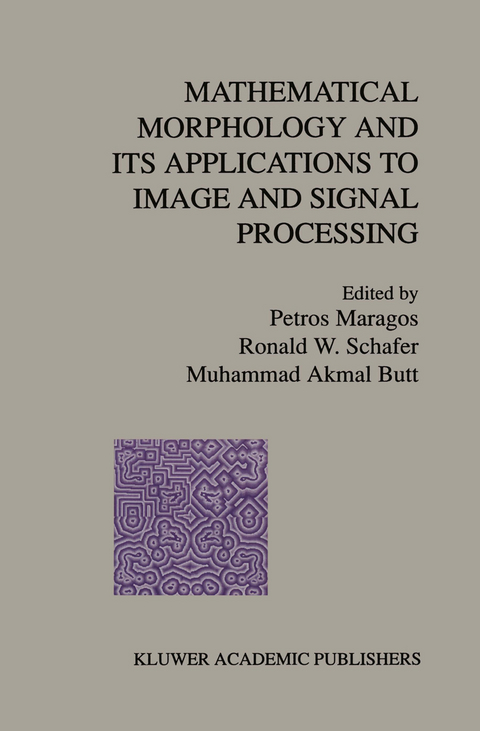
Mathematical Morphology and Its Applications to Image and Signal Processing
Springer-Verlag New York Inc.
978-1-4613-8063-4 (ISBN)
MM was initiated in the late 1960s by G. Matheron and J. Serra at the Fontainebleau School of Mines in France. Originally it was applied to analyzing images from geological or biological specimens. However, its rich theoretical framework, algorithmic efficiency, easy implementability on special hardware, and suitability for many shape- oriented problems have propelled its widespread diffusion and adoption by many academic and industry groups in many countries as one among the dominant image analysis methodologies.
The purpose of Mathematical Morphology and its Applications to Image and Signal Processing is to provide the image analysis community with a sampling from the current developments in the theoretical (deterministic and stochastic) and computational aspects of MM and its applications to image and signal processing. The book consists of the papers presented at the ISMM'96 grouped into the following themes:
Theory
Connectivity
Filtering
Nonlinear System Related to Morphology
Algorithms/Architectures
Granulometries, Texture
Segmentation
Image Sequence Analysis
Learning
Document Analysis
Applications
Theory.- Metric Convexity in the Context of Mathematical Morphology.- Support Function and Minkowski Addition of Non-Convex Sets.- Lattice Operators Underlying Dynamic Systems.- Comparison of Multiscale Morphology Approaches: PDE Implemented via Curve Evolution versus Chamfer Distance Transforms.- An Attribute-Based Approach to Mathematical Morphology.- Spatially-Variant Mathematical Morphology: Minimal Basis Representation.- The Generalized Tailor Problem.- Discrete Random Functions: Modeling and Analysis Using Mathematical Morphology.- Morphological Sampling of Random Closed Sets.- Connectivity.- Connectivity on complete lattices.- Practical Extensions of Connected Operators.- Region Adjacency Graphs and Connected Morphological Operators.- Space Connectivity and Translation-Invariance.- Filtering.- Morphological Filters for Dummies.- Alternating Sequential Filters by Adaptive-Neighborhood Structuring Functions.- Quadratic Structuring Functions in Mathematical Morphology.- MRL-Filters and their Adaptive Optimal Design for Image Processing.- Weighted Composite Order-Statistics Filters: Optimal Morphological Pattern Recognition.- Nonlinear Systems Related to Morphology.- Links Between Mathematical Morphology, Rough Sets, Fuzzy Logic and Higher Order Neural Networks.- Grey-Scale Soft Morphological Filter Optimization by Genetic Algorithms.- Soft Morphological Operators Based on Nonlinear Lp Mean Operators.- The Viterbi Optimal Runlength-Constrained Approximation Nonlinear Filter.- Algorithms, Architectures.- Recursive Morphology using Line Structuring Elements.- A Morphological Algorithm for Linear Segment Detection.- Toward the Optimal Decomposition of Arbitrarily Shaped Structuring Elements by Means of a Genetic Approach.- A Data Dependent Architecture Based on Seeded Region Growing Strategy for Advanced Morphological Operators.- Implementing Morphological Image Operators via Trained Neural Networks.- Granulometries, Texture.- Optimal and Adaptive Design of Reconstructive Granulometric Filters.- Periodic Lines and Their Application to Granulometries.- Local Grayscale Granulometries Based on Opening Trees.- Integrating Size Information into Intensity Histogram.- Probabilistic Model of Rough Surfaces Obtained by Electro-Erosion.- A Textural Analysis by Mathematical Morphology.- Segmentation.- Computation of Watersheds Based on Parallel Graph Algorithms.- Segmentation Algorithm by Multicriteria Region Merging.- Temporal Stability in Sequence Segmentation using the Watershed Algorithm.- The Dynamics of Minima and Contours.- A Morphological Interpolation Method for Mosaic Images.- Image Sequence Analysis.- Multivalued Morphology and its Application in Moving Object Segmentation and Tracking.- Mathematical Morphology for Image Sequences using the Knowledge of Dynamics.- Motion Picture Restoration Using Morphological Tools.- Segmentation-based Morphological Interpolation of Partition Sequences.- Learning, Document Analysis.- Set Operations on Closed Intervals and their Applications to the Automatic Programming of MMach’s.- Automatic Programming of MMach’s for OCR.- Morphological Preprocessing and Binarization for OCR Systems.- Adaptive Directional Morphology with Application to Document Analysis.- Applications.- Segmentation of 3D Pulmonary Trees Using Mathematical Morphology.- Automatic 3-Dimensional Segmentation of MR Brain Tissue using Filters by Reconstruction.- Watershed Analysis and Relaxation Labelling: A Cooperative Approach for the Interpretation of Cranial-MR Images Using a Statistical Digital Atlas.- Robust Extraction of AxonFibers from Large-scale Electron Micrograph Mosaics.- Strong Edge Features for Image Coding.- Water Depth Determination using Mathematical Morphology.- Geometrical and Topological Characterization of Cork Cells by Digital Image Analysis.- Author Index.
| Reihe/Serie | Computational Imaging and Vision ; 5 |
|---|---|
| Zusatzinfo | XII, 476 p. |
| Verlagsort | New York, NY |
| Sprache | englisch |
| Maße | 155 x 235 mm |
| Themenwelt | Informatik ► Grafik / Design ► Digitale Bildverarbeitung |
| Informatik ► Theorie / Studium ► Künstliche Intelligenz / Robotik | |
| Mathematik / Informatik ► Mathematik ► Algebra | |
| Naturwissenschaften ► Physik / Astronomie ► Optik | |
| Technik ► Elektrotechnik / Energietechnik | |
| ISBN-10 | 1-4613-8063-4 / 1461380634 |
| ISBN-13 | 978-1-4613-8063-4 / 9781461380634 |
| Zustand | Neuware |
| Informationen gemäß Produktsicherheitsverordnung (GPSR) | |
| Haben Sie eine Frage zum Produkt? |
aus dem Bereich


